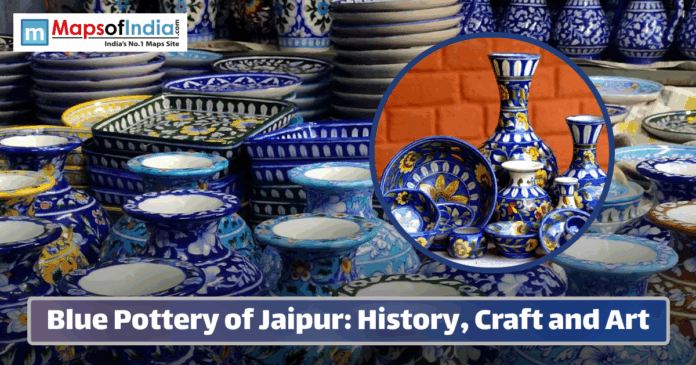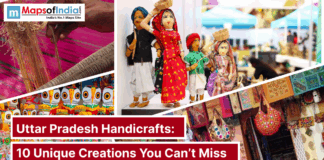The art of Blue pottery, which is practised in the Jaipur region of Rajasthan, is one of the unique and aesthetic styles of pottery that is famous all over India. This art style is known for its unique and aesthetic looks. Over time, with various other influences, this art has accepted trades from art forms combining Persian, Chinese, and some other regions of India influences that helped them to create something more unique and special to the state of Rajasthani. The craft created through this art is admired for its beauty, durability, and artistic precision. This small and unique form of art has become a cultural symbol of Jaipur. Most of the time, this is considered the art form that shows the reflection of the city’s royal heritage and creative spirit.
The Historical Journey of Blue Pottery
If we sit and try to track back the origin of blue pottery, we can trace its roots starting in Persia and Central Asia. These are the areas where the art of glazed ceramics expanded rapidly during the 14th century. According to historians, it is believed that this form of art reached India through the Mughal courts. And with different variations and accepting cultural forms, it found its home in Jaipur during the 18th century. Maharaja Sawai Ram Singh II is credited with promoting the craft after artisans from Delhi and Persia brought it to his court. Over time, local potters adopted the technique using native designs inspired by Rajasthani art and architecture. This blend of cultures gave rise to Jaipur’s signature style of blue pottery.
The Unique Composition of Blue Pottery
The art style of blue pottery that is practised in Jaipur is different from the known traditional pottery style practised across India. This pottery style, which is made in Jaipur, is made using the special clay that is found in some areas of Jaipur. This pottery is crafted from a mixture of quartz stone powder, glass, multani mitti, borax, and gum. Due to the use of this different material to make this, it became different from earthenware since it does not require clay at all. To make this pottery, most of the natural ingredients are used, and due to this, natural minerals lend this pottery its unique characteristic of blue and turquoise shades. Use of these different kinds of minerals not only enhances their aesthetic appeal but also makes them lightweight, durable, and water-resistant.
The Art of Making Blue Pottery
This beautiful art style is not that simple to make; the process of producing this is really hard labour. There are various stages involved that need to be followed to achieve the desired result. In the beginning, the potters need to properly mix the raw materials, that mixture will help them create dough-like clay. There are different techniques used to then mould the mixture into various forms, like using plaster moulds or hand techniques. After the desired shape is given, they are dried properly, and then these pottery items are coated with a white glaze, which is created from the mixture of powdered glass, and afterwards are hand-painted with different but cultural designs using cobalt oxide blue or copper oxide green. When the painting is done, the completed pottery is fired in a kiln where they can control the temperature, which can help them to fix the glaze and colours. After the multistep and difficult process, the result is gotten into a luminous piece that shines with a glossy finish.
The Signature Designs and Motifs
The thing that makes this blue pottery created in Jaipur special than the pottery created from other parts of India is that the pots have delicate hand-painted patterns. The known traditional pottery designs have various features of floral motifs, arabesque vines, and geometric patterns that are done after taking inspiration from Mughal art and Persian aesthetics. Peacock’s lotus flowers and intricate foliage are common elements that are used to symbolise nature and beauty. Over time, the form of these arts evolves, which keeps this craft relevant for modern audiences.
Centres of Production and Community Involvement
This famous art style of blue pottery is mainly practised around the pink city of Jaipur. But it’s not limited only to this small city. Some small clusters exist, which are in nearby towns such as Sanganer and Neota. When we visit here, we can see that many families have been practising this craft for many generations, and with the next generation, they are passing down the skills of blue pottery making. In these small areas around Jaipur and in some parts of Jaipur, there are communities that are working in small workshops where each artisan specializes in a particular stage of production. The painting on this pottery is mostly done by women. Painting intricate designs while men handle moulding and firing.
Problems Encountered by Artisans
Blue pottery is famous across India and the world, but there are still some challenges that exist. To begin with, as we know, this process of producing the art is time-consuming and expensive. While the profit generated after selling this is not worth it. Return on investment is really low. The process is time-consuming and expensive. The artist who makes this pottery faces not having of modern equipment to use. They are still doing this by hand and at the same time are computing with the mass factory-produced goods. The financial support from the government is not sufficient. The market reach of this artist is not that big, so the middleman gets a larger share of the profit. Also, the younger generation is avoiding learning this art.
Conclusion
The distinctive pottery work of the Blue pottery, which is renowned in the Jaipur area of Rajasthan and is a timeless piece of art and craftsmanship. This artmen ship has been carrying a history behind its creation, and all that it began evolving from the Persian heritage and gradually found a new place settling down in Jaipur, where Rajasthani elegance is a story of cross-cultural assimilation and innovative expression. With this aesthetic form of art, it has kept individuals constantly inspired to enjoy its beauty, accuracy, and symbolism. Despite this, there are challenges that are being addressed with the assistance of the government and NGOs. Amidst the challenges, the artists remain firm and are still practising the art. Blue pottery is not something that is created as an art to appear beautiful, but it is a living tradition with the soul of Jaipur, too.





